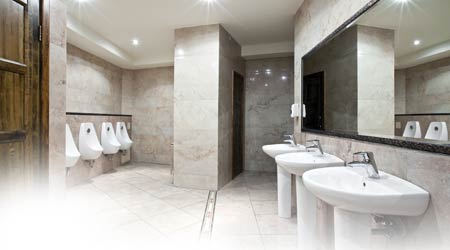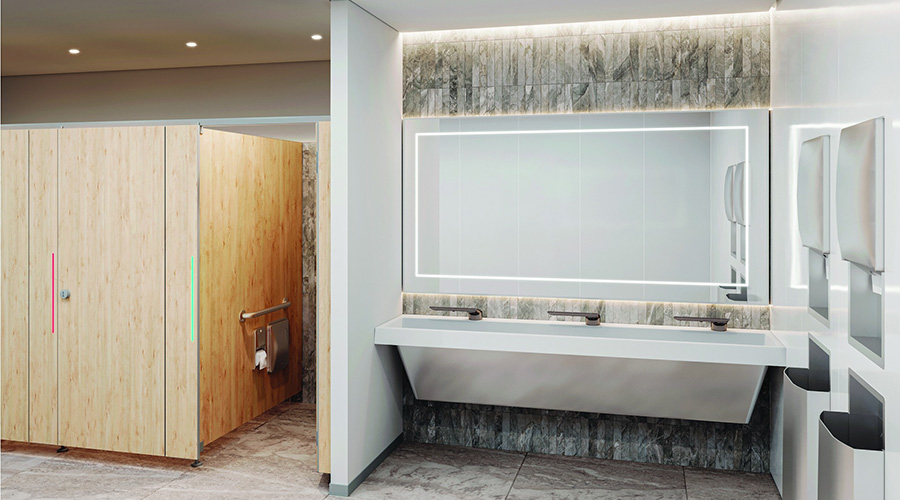 Besides focusing on reduced water use via efficient flush and flow fixtures, selecting products for upgrades also needs to involve careful consideration of user hygiene.
Besides focusing on reduced water use via efficient flush and flow fixtures, selecting products for upgrades also needs to involve careful consideration of user hygiene.Plumbing Systems: Flush Fixture Upgrades
Tankless-toilet upgrades and retrofit kits can help conserve water usage in commercial and institutional facilities
Taking on toilets
Most commercial facilities stay away from tank-type toilets, since they take longer to refill and require more routine maintenance with commercial use estimates. Commercial spaces also have the water supply lines capable of providing the proper flow to tankless toilets. For facilities with existing tank toilets, retrofit kits are available that can turn a typical toilet into a dual-flush system.
Commercial toilets can come with either a pre-installed dual-flush system, including a dual-flush valve — push the handle down for 1.6 gallons per flush (gpf) and up for 1 gpf with, an average use rate of 1.28 gpf based on typical usage calculations — or a low-flow flushometer, which typically come in 1.1 gpf and 1.28 gpf models.
The problem with dual-flush toilets is occasional user error in flushing, resulting in frequent clogs if attempting to flush solids with the lower flush rate. The low-flush fixture is a good option, but managers have to make sure in retrofits that the bowl fixture and piping are sized properly as not to result in any residual problems. These fixtures can save 20-31 percent of flush water consumption when compared to their 1.6 gpf alternatives.
Urinal considerations
One common question in design meetings involves the installation of waterless urinals as options to typical urinals with automatic or manual flushometers. While waterless urinals have their applications, managers need to be sure the urinals meet application needs and user expectations. Newer waterless urinal technology has helped suppress odors encountered with early models, but the systems still require add preventive maintenance and material cost related to maintaining and replacing membranes.
Even some newer waterless urinals do not eliminate odors, and they can add significant housekeeping and maintenance tasks to a department’s already stretched resources. While they do significantly reduce water use and subsequent water waste, a good compromise compared to a typical installation might involve specifying a 0.125 gpf urinal, which reduces water use compared to the typical 1.0 gpf urinals by 87.5 percent. If this reduction is too steep for a particular application, managers can consider urinals with flush rates in between, which can greatly reduce water use compared to the baseline 1.0 gpf.
Unfortunately, the drawbacks with any flushometer remain the same, with their potential for non-calibrated and faulty devices that can result in decreased efficiency and lower-than-expected water savings. Many urinal manufacturers offer a sleeker, all-in- one model with the flushometer integrated into the porcelain housing, but this design can lead to an increased replacement costs due to challenges in replacing individual components and increasing difficulty in troubleshooting problems.
Eye on hygiene
Besides reduced water flows through efficient flush and flow fixtures, the process of selecting products for upgraded plumbing systems and restrooms also needs to involve careful consideration of user hygiene. The CDC recommends that users wet their hands, soap and lather for a minimum of 20 seconds and rinse thoroughly. Each stage of this process involves a key restroom product.
Automatic motion-sensor faucets, although sometimes frustrating, can help decrease water use with intermittent cycles, and they can reduce the spread of germs by eliminating contact with contaminated water faucets. Installing automatic soap dispensers helps decrease unnecessary contact with germ-covered surfaces.
For managers interested in applying the newer WELL Building Standard, minimally they must provide fragrance-free antibacterial soap, disposable paper towels — air dryers are allowed but cannot be a pure substitute — and liquid soap in disposable dispensers in sealed cartridges or bar soap on a fast-drying pan. The sink column also must be at least 8 inches long, and the horizontal distance between the center of the water column to the edge of the sink is at least 4 inches in all directions.
Dan Forino, P.E., CCP, LEED AP BD+C, WELL AP, is regional director for Horizon Engineering Associates in New York City. Forino has 11 years of experience in the building commissioning industry, and he oversees HEA’s health care team focusing on the regional healthcare institutions, as well as the firm’s sustainability and indoor air quality consulting divisions. HEA on LinkedIn: www.linkedin.com/company/horizon-engineering-associates-llp. Twitter: @HEA_Energy. Facebook: https://www.facebook.com/HorizonEngineeringAssoc
Related Topics:














